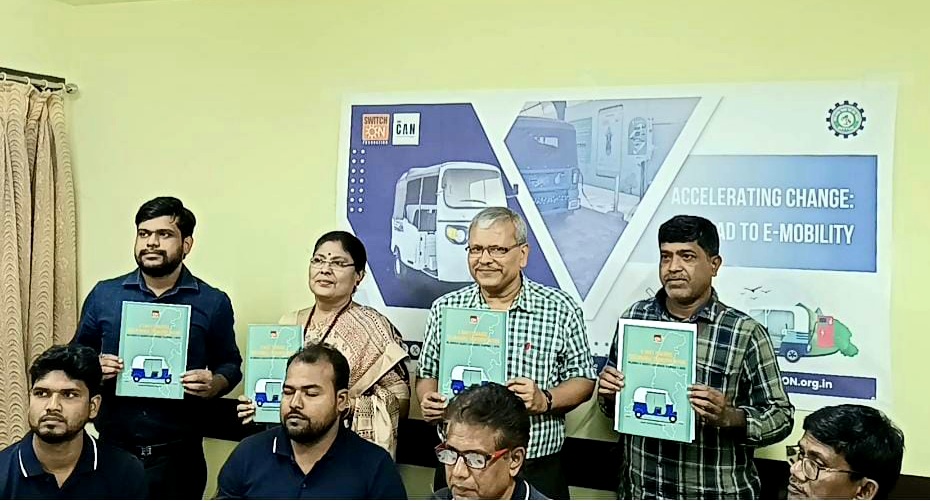Staff Reporter : kolkata, 19th February 2025: India Clean Air Network and SwitchON Foundation, in partnership with the Tollygunge Auto Union, organized a roundtable discussion on the transition of auto drivers to electric vehicles (EVs). The event aimed to assess the interest, challenges, and concerns of auto drivers in adopting a more sustainable mode of transportation. The discussion brought together key stakeholders, including auto unions, university professors, and mobility experts, to explore the opportunities and solutions for encouraging electric vehicle adoption among auto drivers.
The roundtable was attended by Mr. Rabin Bijali, Secretary of the Tollygunge Auto Union; mobility expert Mr. Sanjiv Gopal, Mr. Siddharth Srinivas, Mr. Achuthan from Asar Social Impact joined the session virtually, Professors from the Mechanical Engineering Department; E-auto dealers; and auto drivers from Kolkata. Participants acknowledged that transportation is a major contributor to air pollution in the city, underscoring the need to transition from petrol, LPG, and CNG-powered vehicles to cleaner electric alternatives.
Mr. Ajay Mittal, Executive Consultant of SwitchON Foundation and Co-Chairperson of India Clean Air Network, emphasized the importance of equipping auto drivers with knowledge and resources. He stated, “Empowering auto drivers with the necessary knowledge and tools to transition to electric vehicles is the core focus of this workshop. Understanding their challenges and working collaboratively with stakeholders will help create a supportive ecosystem, ensuring a smooth and cost-effective transition.”
The team leader of the EV department from a renowned auto industry said, “The vehicle developed by our company has been develop to benefit all the customers and is well equipped with latest technology which has 9kw battery with 5 years warranty on battery and other parts to support for long service.”
Auto-rickshaws play a crucial role in urban transport across India. In Kolkata, there are 125 registered routes and over 11,000 permits, according to the Transport Department (2017). Despite their significance, these three-wheelers are a major source of urban air pollution. According to a 2020 report by The Energy and Resources Institute (TERI), autos contribute 11% of particulate matter in Kolkata’s air. Since 2015, the city has been classified as a non-attainment area under the National Clean Air Program (NCAP) due to high pollution levels. To mitigate these emissions, the transition to electric auto-rickshaws is a critical step. However, challenges such as public acceptance, infrastructure readiness, and cost barriers continue to hinder widespread adoption. Presently, Kolkata has approximately 3,500 electric vehicles, with projections indicating an increase to over 355,000 by 2030, as per a 2024 article on parking digitization and EVCI trends by Tirthankar Basu.
An auto driver currently operating an electric vehicle (EV) auto on the Tollygunj route said, “The EV auto is a very good vehicle. I used to drive a CNG auto, and waiting in line to refuel was very tiresome. With the EV, I can easily charge without the hassle of queuing. I have traveled 200 km in the auto very easily and conveniently.”
Concerns About E-Autos & Why Some Prefer CNG-The study also revealed key concerns among auto drivers regarding the shift to electric vehicles. The primary reasons for preferring CNG over e-autos include:
• 70% of surveyed auto drivers find that the shorter refuelling time of CNG is a major advantage.
• 29% prefer CNG due to its better availability of refuelling stations.
• 32% of respondents see battery breakdowns as a significant concern with e-autos.
• 27% of surveyed auto drivers cite the unavailability of sufficient charging stations across Kolkata as a major issue.
• 21% believe that the longer charging time of e-autos is a drawback.
• 20% are concerned about the shorter battery range of e-autos compared to CNG autos.
These findings highlight the infrastructural and technological improvements needed to make electric autos a more viable and convenient option for auto drivers in Kolkata.
Mr. Rabin Bijali, Secretary of the Tollygunge Auto Union, expressed optimism about the shift to EVs. He stated, “I am truly excited about the prospects of transitioning to electric vehicles. This workshop has provided us with crucial knowledge about government subsidies and policies for EV adoption. We now recognize that this shift will not only reduce our operational costs but also contribute to a cleaner environment.”
The event aimed to promote proactive and practical strategies for encouraging electric auto adoption in Kolkata. Discussions covered critical aspects such as charging infrastructure, government incentives, and advancements in EV technology, helping participants gain a deeper understanding of the transition process.
India Clean Air Network and SwitchON Foundation also released a study titled “A Shift Towards Sustainable Transportation: Willingness of Kolkata’s Auto Drivers to Embrace E-Autos.” This research, conducted across Tollygunge Metro, Garia, Ruby, Ballygunge, and other areas, provided a broad regional perspective. A total of 453 responses were collected using purposive sampling, exceeding the sample size required for a 95% confidence level. The survey, conducted between June 5 and June 6, 2024, explored the feasibility of replacing CNG auto-rickshaws with zero-emission alternatives and assessed the willingness of drivers to transition to eco-friendly fuels.
Key findings from the study revealed that 71% of surveyed auto drivers were willing to switch to CNG autos, while 29% showed a preference for e-autos. The primary factors influencing the decision to adopt EVs included lower fuel expenses (39%), government incentives (31%), and environmental considerations (30%).
The roundtable discussion and research findings mark an important step toward a more sustainable urban transport system in Kolkata. By fostering awareness and addressing challenges, initiatives like these will help accelerate the adoption of electric mobility, benefiting both the environment and auto drivers in the long run.






Be First to Comment